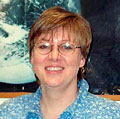 |
|
|
| Author |
Message |
Patty_Cie

Joined: 23 Mar 2004
Posts: 87

|
 Posted:
Wed Jun 23, 2004 6:20 pm Posted:
Wed Jun 23, 2004 6:20 pm |
  |
June 15, 2004 Tuesday
6:30 PM Alaska time
In the past, scientists would do stomach analysis for predator/prey interaction information, i.e. the food web. Today, scientists use isotope signatures. Isotopes are atoms that have more or less neutrons than the average atom for that element. When an organism eats, it incorporates a small portion of the carbon and nitrogen from the food into its body tissues. From the signature of isotopes carbon-13 and nitrogen-15 found in body tissues, scientists can identify each organism's tropic level on the food web and determine the origin of the prey items. For the Shelf Basin Interaction project, principal investigator, Ken Dunton, from The University of Texas Marine Science Institute is further investigating Arctic Ocean food web dynamics using carbon and nitrogen isotopes.
Susan Schonberg and graduate student, Craig Aumack, are the onboard investigators. At every process station, Susan and Craig collect particulate organic matter (POM) and zooplankton from the water column and invertebrates from the seafloor. They also will try to collect epilithic invertebrates (animals that are encrusted onto rocks) using a rock dredge when we arrive at the 100 m Barrow Canyon station (see journal entry May 27).
To collect POM, water samples are taken from the CTD's 10 m and chlorophyll maximum bottles. The water is filtered onto a glass fiber filter (GF/F) until a thick layer of POM is collected. During the cruise, 1 to 7 liters of water has had to be filtered to obtain enough matter. The POM sample is put into a labeled vial and dried inside a 60 degree Celsius oven. The procedure is repeated four times for every water sample. When the samples are returned to Texas, the POM layer is peeled away from the GF/F and analyzed for carbon-13 and nitrogen-15 isotope signatures with a mass spectrometer.
The zooplankton groups provide the zooplankton sample for Susan and Craig (see journal entries May 24 and 26) and the benthic group collects the core samples (see journal entries June 11 and 13). Susan and Craig identify and sort the animals by species. They can often be seen using a dissecting microscope and taxonomical keys to verify their identifications. The animals are put into labeled vials and placed into the drying oven. Like the POM samples, the dried zooplankton and benthic organisms are returned to the University and analyzed for carbon-13 and nitrogen-15 isotope signatures.

Susan Schonberg uses a dissecting microscope to see specific characteristics of each organism so she can identify the species.

Sometimes it is necessary to use a taxonomical key to identify the species.
To see photographs taken by Steve Roberts of UCAR/JOSS, click here. |
|
|
    |
 |
|
|
|
View next topic
View previous topic
You cannot post new topics in this forum
You cannot reply to topics in this forum
You cannot edit your posts in this forum
You cannot delete your posts in this forum
You cannot vote in polls in this forum
You cannot attach files in this forum
You can download files in this forum
|
Powered by phpBB 2.0.11
© 2001, 2002 phpBB Group :: FI Theme ::
All times are GMT
| |
